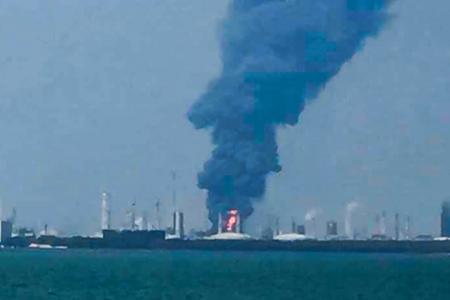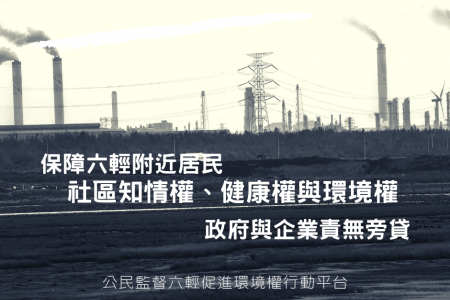The Explosion of the Sixth Naphtha Cracker in Yunlin, Taiwan. How can we improve the governance dilemma of petrochemical industry?
Wen-Ling Tu
June 11, 2019 | Reflections
This original Chinese version of this article was published on April 19th, 2019 in the Initium Media, a Hong Kong-based digital media providing news and opinions to Chinese-speaking readers worldwide. The article was written in response to the explosion incident in the 6th naphtha cracker complex on April 7th, 2019. Through the event analysis, the article aims to share STS insights with the Taiwan public.

Figure 1. Photo credit: the initium https://theinitium.com/article/20190408-taiwan-fcfc-explosion/
On April 7th, 2019, there was a loud blast at the Formosa Chemicals and Fiber Corporation (FCFC) ARO-3 located in the 6th naphtha cracker complex, Yunlin County, Taiwan. Many residents’ windows were shattered and nearby fish farms were covered by grease and dust from the explosion. Many people had flashbacks to earlier petroleum gas explosions in Taiwan, which occur all too often.
A similar explosion at the same 6th naphtha cracker happened in 2010. After a two year investigation, it was concluded that there had been serious environmental damage but evidence was scarce because investigations of environmental and crop damages were not instantaneously and comprehensively investigated at the time of the incident. Environmental Impact Assessment (EIA) committee members could only infer causal relationships based on the timing of incident, the diffusion route of pollutants and the massive death of fish.
Formosa Plastics, however, argued that there was significant “scientific uncertainty” about impacts, arguing that environmental monitoring data showed no violation and the death of fish can be caused by many reasons. Formosa thus argued that “it is impossible to assess the environmental impact”. Nine years later, Taiwan haven’t learned how to prevent the same disaster.
In Taiwan, it is common for people living in fence line communities of aging industrial facilities to have no idea how the factories operate or how to avoid risk if there is an explosion. As Kim Fortun has suggested (in writings about “late industrialism”), the risks are compounded by the aging of many industrial facilities and through “tight coupling of historically sedimented sociotechnical, political economic, eco-atmospheric, cultural and discursive systems” (Fortun 2014). The complexity of the conditions is often simplified by mainstream discourses, which divert people’s attention away from the structural problems of industrial risks.
Because of insensitivity to the risks of the petrochemical industry, Taiwan’s environmental rules are inadequate and defective. Insufficient scientific investigation and the limitations of monitoring equipment further restrain knowledge production about pollution and health in Taiwan. Further, industrial risk often produces unevenly distributed vulnerabilities and harms on low-income communities. Due to the livelihood stress and inequity of accessing information, people in disadvantaged communities have little opportunity to have their voices heard.
There are, however, important examples of citizen environmental activism in Taiwan. In the industrial city of Kaohsiung, for example, citizens facilities have fought to prevent expansion of high risk activities and facilities.

Figure 2. Government and Formosa Plastic should ensure community right to know, health right and environmental right for the 6th naphtha cracker’s fenceline community. Photo credit: Environmental Right Foundation http://erforg.weebly.com/info
The explosion of the 6th naphtha cracker can’t be treated as a single event; big accidents always have small beginnings. In fact, many previous studies found that the health risks tended to be high for the people living in the vicinity of the 6th naphtha cracker. The 2014 VCM exposure study (Huan et al., 2016), which comprised the health assessment for schoolchildren located in the vicinity of the 6th naphtha cracker also showed that schoolchildren living in the vicinity of its VCM factory had an increased risk of exposure to hazardous air pollutants. Apparently, the risks caused by the 6th naphtha cracker should be examined holistically.
It is important then for Taiwan’s government to require all petrochemical industrial parks to set up and operate fence line monitoring systems to measure a comprehensive list of all criteria pollutants and toxic contaminants. The petrochemical companies should pay for the monitoring cost and internalize the externality. The companies also need to help communities understand potential air quality impacts of factory emissions and proactively provide notification to the community if emissions exceed established thresholds. Such mandates will enable the companies to quickly address significant changes in emissions, help regulatory agencies to understand emission patterns and form better policies, and ensure the community right to know.
Last year (2018), Taiwan’s Ministry of Economic Affairs has promised to conduct a “holistic” examination of the 6th naphtha cracker facility (after its 20-year operation) that can be a model for review of other industrial facilities.[9] [10] Unfortunately, however, the examination as conducted is more like a free government services to help with upgrading the facility — with no consideration for community right to know. As a result, it is hard to expect significant structural and systemic improvements.
Given these problems, it is worth considering what can be learned from other environmental governance in other places. In California, for example, rule 1180 adopted by the California South Coast AQMD mandates the implementation of real-time observations of air quality at or near the fence line of all major refineries.
The cost for the firms is high but are an internalization of costs currently externalized. If such a business model (that protects public health) doesn’t seem feasible in Taiwan, then we need to return to basic questions about the development path we are on and our dependence on a highly polluting petroleum-based economy.
Unfortunately, it is hard for people in Taiwan to envision alternative development models. Old school thinking about politics, economics and technology inhibit us from seeing alternative paths. Learning about environmental governance in different places is thus crucial and can help us think creatively about transitioning from a brown to green economy. There’s no easy single solution in the era of late industrialism. We need to call for many proposals on different domains and scales to collectively as well as creatively develop solutions.
杜文苓:雲林六輕爆炸,台灣石化工業治理困境,還能如何改善?
[4月7日,位於台灣雲林麥寮的台塑六輕工業區台灣化學纖維股份有限公司(以下簡稱台化)芳香烴三廠,傳來驚天一爆],爆破的威力使許多住家門窗破裂,附近魚塭也佈滿了油污與粉塵,類似的場景彷彿重現了2010、2011年的六輕爆炸事件,提醒了人們石化氣爆風險未曾遠離台灣。
然而,各方回應一如以往:六輕廠區操作人員並未在發現洩漏的第一時間對外通報,爆炸發生後台化高層則輕描淡寫地指出只是液態瓦斯管破裂燃燒,並沒有毒性物質;環保署也表示監測並無異常;地方環保局則以《空氣污染防制法》裁罰;農漁災情在兩天後陸續傳出,居民要求六輕必須負起責任,六輕則表示農漁損部分是否與爆炸有關需要進一步調查。
這些回應彷彿是2010年六輕爆炸:事件的翻版,當時六輕附近的農損也都在幾天後發生,同樣有浮油、落塵的問題,環保署依據《環評法》第18條要求台塑提出「環境影響調查報告書」以釐清影響範圍與程度,但整個程序歷時兩年,才做出了六輕大火與環境危害有「因果關係」之結論。[之所以費時長久],是因為事發當時許多環境危害與農損等相關證據沒有即時而完整地採集調查,環評委員僅能從火災後產生的污染物與擴散途徑、配合工安事件與水產死亡的時間點推論因果關係;而台塑則以環境監測沒有污染超標、養殖魚類死亡原因很多、不一定是火災造成等「科學不確定」作為爭論重點,加上平日監測資料缺失,因此提出「無法評估環境影響」的說法。
即便去年台灣啟動了「20年六輕總體檢」的執行作業,推動有關政府機關對台塑六輕進行全面檢查計畫,但對於災害預防與緊急應變,我們的因應措施顯然仍不及格。再度發生六輕大爆炸事件的今日,我們是否已經記取九年前的教訓?
##晚期工業主義與面對石化風險的遲滯性
國際科學的社會研究學會(Society for Social Studies of Science)理事長 Kim Fortun 教授認為,工業災難日常化、工業化運作產生的風險、廢棄物溢流等問題,是晚期工業主義(late industrialism)的特徵。她認為,在科學技術進步發達的今天,這些現象仍層出不窮,是因為工業風險災害的發生,不僅與工業設備的老舊化有關,也與陳舊而僵化的主流政治、經濟、社會、技術運作息息相關。試想,在工業設施建置之初,可能不會預想未來設施老舊後會有陳出不窮的各類風險問題,沒有相關法律規範社區與工業區需有隔離帶的設計,也沒有各種空氣監測、或風險評估瞭解地方環境狀況,更沒有爆炸發生通報體系或緊急疏散計畫的要求。不要懷疑,這是台灣許多老舊工業區周遭社區面臨的現況,不知道附近工廠運作情形,也不知道爆炸發生要如何避難。
這個運作系統總是巧妙地把風險災難問題,透過論述與問題診斷的簡化,與工業體系背後複雜的自然社會結構性問題脫勾。例如,六輕爆炸問題被視為是一個單一的意外事件,簡單歸結為管線腐蝕問題,似乎通過汰換管線就可以避免意外;廠方第一時間說明則把重點放在不會影響營業上;而爆炸發生可能存在的系統性問題,如管線腐蝕與興建之初沒有考慮氣候環境影響、工廠安全作業系統沒有充分落實,以及居民面對突如其來的爆炸的因應對策及教育等,皆被忽視。在晚期工業主義的框架中,老舊工業設施發生問題後只能透過更新技術設備來解決,而有毒廢棄物的整治方案就是把毒物送到另一個更邊陲之地,眼不見為淨。我們看不到更廣泛的問題成因,而解決問題的知識生產、法律決定與各種層次的治理中,商業利益更勝於風險防災的考量。
Fortun教授以化學災害為例指出,工業化學對人體健康、生態、乃至於大氣系統的危害並不缺乏證據,但卻不被積極的重視。誠然,工業化學的發展帶來許多便利性與商業利益,但主流媒體將化工體系描繪為提供工作、安全與效率的萬能之物,其對人體、生態乃至大氣體系破壞的風險卻被隱匿不揚。這使我們在面對問題與思考解方時,出現了資訊的偏誤與決策的盲點。
上述現象對台灣而言並不陌生,否則,沒有石油原料的台灣如何成為石化王國,享有許多產業租稅優惠與補貼,卻沒有相應之風險治理機制?對於石化風險的遲滯性,使我們桎梏於環境法規的缺陋,以及科學調查設計不適當與不足的窘境,而科學監測儀器設備與現實條件的種種限制,更難以生產出污染與身體受害相關性的知識。工業污染代價的承受者,往往不均質地分佈在社經地位弱勢的社區,生活的壓力與知識訊息的不平等,也壓抑了他們向社會發聲的機會。
##司法的介入與治理轉型的契機
六輕的爆炸事件無法以單一意外事件看待,其運作的各類風險,更需要全面性的被檢視。事實上,除了九年前的大火問題,雲林縣政府曾於2009-2012年間委託台大公衛學院調查六輕周遭鄉鎮居民罹癌率與六輕距離遠近的關聯性,[研究發現,鄰近六輕之雲林縣台西鄉、麥寮鄉居民癌症發生率為雲林其他鄉鎮居民的1.29倍];另一研究分析也指出,[位於六輕北邊的彰化縣大城鄉台西村,其居民在六輕營運後第10年起的癌症發生風險是大城鄉其他村居民的2.66倍。]
2015年8月,74位雲林縣居民組成的「台西鄉六輕污染傷害聯合求償自救會」向雲林地方法院遞狀,控告六輕廠區中的台塑、南亞、台化、台塑石化、麥寮汽電等五家公司。這場訴訟走了三年多,法院審理卻仍在原地踏步,因為這一污染受害案的被告(台塑),是一個擁有政治經濟影響力且仍正在運作的石化集團。雖然有關六輕廠區運作過程中釋放有毒物質、有不少違規紀錄的批評並不少見,更有流行病學調查指出居民健康受損與工廠運作排放的關連性,但由於六輕屬於台灣兩大石化工業體系之一的台塑集團,其在台灣經濟藍圖上的影響力,卻很可能使政府與社會產生工業風險盲。
面對複雜的空污因果關係鑑定,司法攻防中對於各類相關證據的要求,將更嚴格檢視我國環境治理機制缺陋的問題,迫使相關主管機關以及企業共同擔負起系統性治理轉型之責。而這個系統性治理轉型的契機應體現在幾個層面:
首先,應該儘速建立完整嚴密的石化工業區環境監測網,強化業者的自主管理,而這些偵測風險之各種建置管理成本,應由廠商負擔。
其次,保障社區知情權,要求廠商建置主動積極的社區通報系統,加強居民對周遭工廠情況的掌握與應變能力,避免一直以來居民只聞爆炸卻不知如何應變的窘境。
第三,對於世界級的石化專區,僅憑地方政府的監督恐難產生有力的管制。政府應考量成立企業付費的石化工安基金,拉高管制層級,並充實建置能有效監督六輕之獨立調查管理單位的能力。
##廠商自主管理與風險成本內部化,台灣能做到嗎?
上述的思考,與目前政府以經濟部結餘款為財源所進行的「六輕20年總體檢」有很大的不同:現行制度並非透過法律規範要求廠商自我嚴格體檢,並藉此令政府掌握石化區的現況;而是政府請來專家輔導六輕產業升級轉型。然而目前體檢基線指標的建立,強調能源、職安、環保三大面向,卻完全沒有社區知情權的考量。因為缺乏公共課責機制,結果是做了政策卻難以看到結構性、系統性的改善,使「一爆再爆」不足為奇。
同樣是以建立石化廠「自主管理」為目標,我們可以參考與台灣環保單位交流密切的美國加州南岸空氣品質管理局(SCAQMD)最近的立法。2017年底,南加州通過1180號法規 (Rule 1180),要求廠商依照工廠排放物質特性,出資在「工廠周界」與「鄰近社區」設置相對應的嚴密監測設備。看似著重監測,但更重要的精神是嚴格地要求廠商自主管理並促成「風險成本內部化」。
在此,自主管理並非放手讓廠商隨意規劃執行,其「自主」監測的品質,必須依據公部門詳細撰述的「空氣監控指南」來執行,廠商並需提供經費供政府建置周遭社區的監測網,雙管齊下讓不同的監測資料相互參照,以系統性的瞭解社區健康風險與石化區運作的因果關係,同時要求這些資訊以公眾友善的方式主動提供給鄰近社區居民。而上述要求必須配合政府許可核發,以促成廠商真正落實資訊揭露與自主管理的要求。
有論者認為,台灣難以師法加州。根據加州官方[2017年12月1日發佈的新聞稿],八個煉油廠將分擔750萬美元的一次性社區監測裝置費用,以及未來每一年350萬美元的操作費用。嚴密的監測體制成為煉油廠運作必須擔負的成本之一,試想,如果台灣政府提出類似的要求,會有什麼樣的回應與後果?政府目前的管制能量能否驅動廠商審慎負責的自主管理?
換個角度想,如果把原本就應該做的風險監測管控成本內部化,卻使這個產業發展失去利基,那麼這樣的產業是不是適合在台灣這塊土地上持續發展?我認為,強調轉型思維的重要性恰恰在此彰顯。石化、鋼鐵等重工業的現行運作模式,其所產生的各種風險成本與各種資源排擠效應,相較於帶來的經濟效益,並不符合台灣整體發展的利益。但在舊有政治、經濟與技術的論述系統挾持下,我們卻可能跳不出框架外看到轉型的選項。加州的空污管制經驗告訴我們,透過新的治理思維與制度設計,強化社區的投入與關注,促成廠商環境成本內部化,或許可以迫使我們面對產業轉型的課題。
面對不可承受之「輕」,沒有單一而簡化的解方,我們亟需在不同層次面向上尋求各種可能的突破方案,包括司法、產業經濟、工程技術、公共行政、媒體論述、企業文化等治理體系以及公民社會能動性的提升,深具創意地為永續的發展路徑擘畫出階段性的目標。而為實踐這些願景鋪設所需之基礎建設,政府則責無旁貸。
**(杜文苓:國立政治大學公共行政學系教授、民主創新與治理中心主任)**
Published: 06/11/2019
